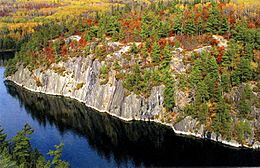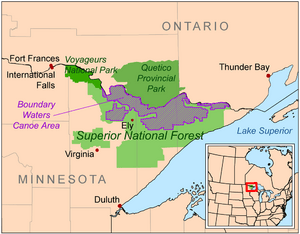Boundary Waters facts for kids
Quick facts for kids
Boundary Waters
Quetico-Superior Country
|
|
|---|---|
|
Region
|
|

A landscape typical of the Boundary Waters region (Voyageurs National Park, Minnesota)
|
|

Protected areas along the international boundary
|
|
| Country | Canada and United States |
| State/Province | Minnesota and Ontario |
The Boundary Waters, also known as the Quetico-Superior Country, is a huge area of wilderness located right on the border between Canada and the United States. It sits between Ontario and Minnesota, just west of Lake Superior. While "Boundary Waters" is a common name for this specific region, it's good to remember that Canada and the U.S. share many other "boundary waters" along their long border.
This special region is part of the Superior National Forest in northeastern Minnesota. On the Canadian side, it includes La Verendrye and Quetico Provincial Parks in Ontario. Voyageurs National Park in Minnesota is also often thought of as part of the Boundary Waters. In the U.S., the name "Boundary Waters" often refers to a specific protected area called the Boundary Waters Canoe Area Wilderness.
This area is famous for its huge network of waterways, including countless lakes and rivers. You'll also find many bogs, which are wet, spongy areas. The landscape was shaped by glaciers long ago, leaving behind ancient Precambrian bedrock covered by thin soils and thick boreal forests. The Boundary Waters is a very popular spot for outdoor activities like camping, canoeing, and fishing. Many people also visit just to enjoy the beautiful natural scenery and relax.
Contents
What Makes the Boundary Waters Special?
The Boundary Waters is unique because of how it was formed. Thousands of years ago, huge sheets of ice called glaciers moved across the land. As they slowly melted, they carved out the many lakes and rivers you see today. The ground underneath is made of very old rock, called Precambrian bedrock, which is billions of years old! Because the soil is thin, the trees in the boreal forests, like pines, spruces, and birches, often grow close together.
This region is a fantastic place for outdoor adventures. You can paddle for days through interconnected lakes and rivers, camp on small islands, and fish for different kinds of fish. It's also a great spot to see wildlife, like moose, bears, and many types of birds.
Nearby Communities
Several towns are located close to the Boundary Waters, making them good starting points for visitors. In Minnesota, these include Ely, Cook, Grand Marais, and Tofte. On the Ontario side in Canada, the town of Atikokan is nearby. These communities often provide supplies and services for people exploring the wilderness.
Protected Areas
To keep the Boundary Waters wild and beautiful, many parts of it are protected. These protected areas help preserve the environment and allow people to enjoy nature responsibly.
Protected Areas in Minnesota
- Superior National Forest: A large national forest that covers much of the U.S. side of the Boundary Waters.
- Boundary Waters Canoe Area Wilderness: A special wilderness area where motorized travel is mostly restricted, making it perfect for canoeing and quiet recreation.
- Voyageurs National Park: A national park known for its interconnected waterways and islands.
- Grand Portage National Monument: A historic site that tells the story of the fur trade and the Ojibwe people.
Protected Areas in Ontario
- Quetico Provincial Park: A large wilderness park on the Canadian side, very similar to the Boundary Waters Canoe Area Wilderness.
- La Verendrye Provincial Park: Another provincial park in Ontario that is part of this vast wilderness region.
These parks and forests work together to protect the unique ecosystem of the Boundary Waters for everyone to enjoy now and in the future.
See also
In Spanish: Boundary Waters para niños

